This was published 7 years ago
Kenya's Samburu National Reserve: A window to the past
By Dilvin Yasa
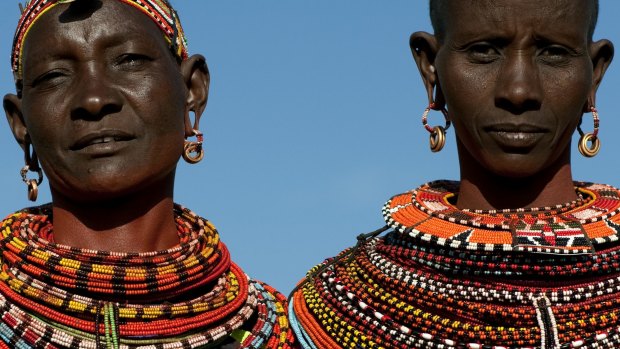
Samburu in traditional clothing.Credit: Getty Images
Under the shade of a hut made from sticks interwoven with old plastic bags, hessian sacks and flattened cardboard boxes, I'm finding myself in a difficult position as my guide insists on treating me to a delicious glass of blood and milk – the traditional diet of the local Samburu people. "It's made with half a glass of fresh milk and half a glass of fresh cow's blood," he tells me, not unlike a sommelier trying to sell me the most expensive bottle on the menu, "I guess you could say it looks like a strawberry milkshake, only it tastes ... bloodier".
I tell him I'll just have to take his word for it and take a look around his hut, which is dark and stifling hot under the full Kenyan sun. On the ground are several pieces of hide that serve as the family's beds, while a crude cooktop fills the space with smoke so dense I can just make out a single canary-yellow dress and handbag hanging from a rusty nail. "Are you hot?" Tepes asks as he pushes out the corner of a piece of cardboard to let more light and air into the hut. "Because look, I have airconditioning!" He laughs in a way that suggests this is not the first time he's told this joke today, and behind him I can see two toddlers playing in the dirt, each one wearing only one shoe. "Actually Tepes, I'm really interested in talking to you about how and why the Samburu people have managed to stick to their traditional way of life for so long, " I say, referencing their polygamous lifestyle and positive attitudes towards female 'circumcision'. "Of course," he smiles. "But please know, if you have any further questions after your visit, you can also get me any time on email, WhatsApp or Twitter – I'm always online." And somewhere in the background, I hear an imaginary boom-tish; the statement is as surprising as the visit itself.
We are in Samburu National Reserve, a rugged parkland 350 kilometres north of Nairobi where the foothills of snowcapped Mount Kenya mesh with the northern desert in a stunning display of acacia trees and grasslands teeming with wildlife, and I am two days into a luxury safari, with my guide James, a local Samburu man, at the wheel. At sunrise and sunset, James and I have watched prides of lions stalk their prey along the banks of the muddy (and croc-infested) Ewaso Nyiro river, and witnessed sleepy leopards in trees carelessly bat at passing herds of elephants, but when James casually inquires whether I might like to take some time out from the wildlife to pop in at a local village, I cannot say yes fast enough. Although closely related to their more-famous Maasai cousins, the Samburu – semi-nomadic pastoralists who rely predominantly on cattle, as well as goats and sheep – are known to be more traditional, and have so far resisted pressure from the Kenyan government to modernise and move into permanent villages. "The way we live today is the same as we lived hundreds of years ago," James tells me as he pulls up outside the village gate where tens of his tribesmen and women have gathered in a flurry of vivid colour. "But first you will need to pay the chief 2500 shillings ($34)." Business, it appears, is business, even among the Samburu.
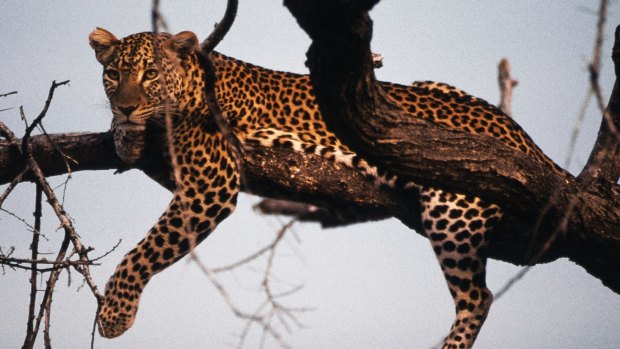
Samburu Game Reserve, Kenya.Credit: Alamy
Having paid my "entry fee", a humming sound begins, soon accompanied by the clatter of silver coins dangling from the womenfolk's intricate neckpieces. A hand is outstretched for me to join in the excitement of the welcome dance and song and I am soon adorned with an ornate head and neckpiece and forced into a traditional dance that sadly, showcases only how terribly unco-ordinated I am. Like the Maasai, the Samburu men perform the kind of cloud-grazing jumps that would make Crossfit fanatics weep like children (the one who jumps the highest is the one who will win the hearts of the ladies, according to tradition) and after I am instructed by Tepes, my guide, to "Take as many photos as you can", I am brought inside the village, known locally as Manyatta where 25 families (180 people in all) reside, and all the kids come racing out of their huts to see the funny "mzungu" (white person) in the wildly inappropriate panama hat.
Central to their village is their parliament – essentially a series of stones placed in a circle – where tribal elders conduct meetings three times a week. One of the more common grievances brought to the meetings? Disproportionate amount of time a husband may spend between his households. "A Samburu man can have up to five wives and each wife and her children with him will have their own hut," Tepes explains as his fellow tribesmen demonstrate how they light their twice-daily fires to keep the predators away. "But if we notice the husband is in residence in one hut more than the others, then that is a serious offence." That's fair, I nod, but why not use a lighter or matches, I ask, indicating the six men stooped over the smoking sticks. "Ah, but we only ever trust in nature."
It's an interesting time to be Samburu. Facing off against the elders who remain insistent on maintaining old-world traditions such as arranged marriages bang on 18 and the aforementioned circumcision of women, are the young who are in increasing numbers travelling to cities such as Nairobi where they are forced by government institutions to modernise and dress like their urban counterparts before they can enrol in study. "It's good that they study, but sometimes when they come back we find their diets have changed and also the way they think," says Tepes, as the mood sours for a moment and we sit in silence. But just as I'm thinking it's over, Tepes claps his hands. "Aha! The children!"
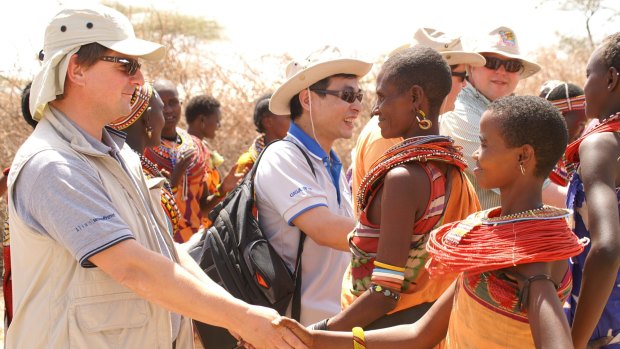
Samburu meet and greet.Credit: Twiga Tours
Full of renewed energy, he ushers me over to a tree where all the village children have gathered under the shade of its leaves. Many are in threadbare T-shirts or have on only one shoe, and as their teacher claps her hands, they sing the English alphabet, followed by a session in which they count from one to 10. The moment is far more mortifying than I can ever articulate, and I quickly rush over to the haphazardly thrown-together marketplace where women, their babies clinging to them, hold out carved animals and beaded bangles for me to buy. Tepes stands by my side, writing the price of each item on his arm with a stick so that each figure comes up the colour of milky coffee and I can't help but think it's not unlike having to go through the gift shop at the end of a visit to an amusement park – only a lot more emotional.
"OK my friend," says Tepes as he walks me and my inappropriate panama hat back to the Jeep. "I hope to see you again real soon, and if not, we can always find each other on Facebook, yes?" And with that, he turns to go and help his fellow tribesmen tend to their cattle
TRIP NOTES
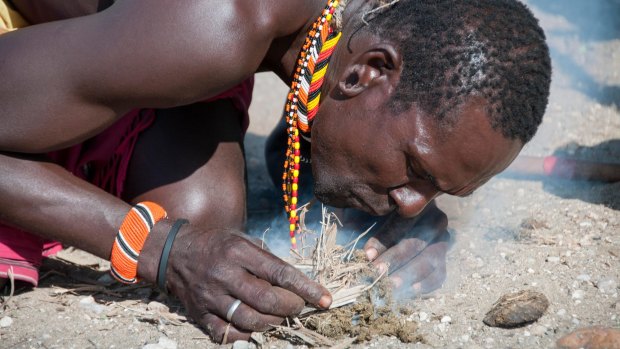
Samburu tribesman making fire.Credit: Alamy
GETTING THERE
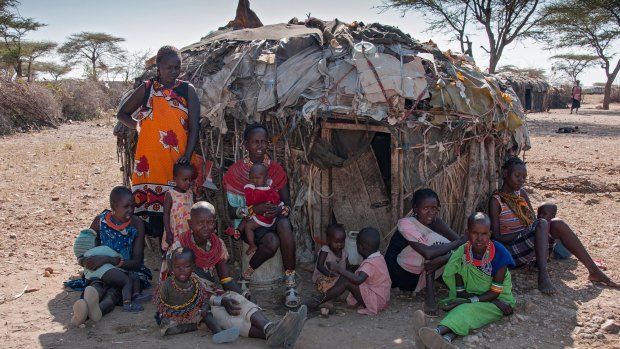
Samburu women and children outside a traditional Samburu house.Credit: Alamy
Etihad flies daily from Sydney to Nairobi via Abu Dhabi. From Nairobi, a swift transfer is required to Wilson Airport south of the city, where you can then catch a morning Air Kenya flight to Samburu. The flight takes an hour and 20 minutes. See etihad.com; airkenya.com
STAYING THERE
Set on the banks of the Ewaso Nyiro river, the Elephant Bedroom Camp – so named because elephants like to come and browse around the unfenced camp – offers 12 luxury tents (each with its own plunge pool), electricity and hot water. Prices start from $US580 a night and includes all meals, safari drives and sundowner drinks.
Dilvin Yasa travelled courtesy of Swagman Tours and Kenya Tourism Board
Sign up for the Traveller Deals newsletter
Get exclusive travel deals delivered straight to your inbox. Sign up now.